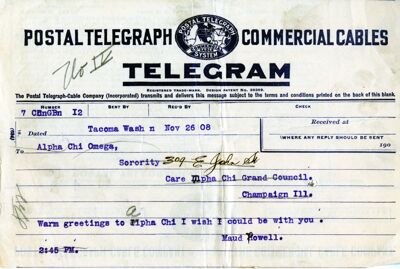Sort by
Hear from our Founders about the beginning of our sisterhood at DePauw University. This presentation was shared in celebration of Alpha Chi Omega's 125th anniversary.

This is a 1908 telegram from Maud Powell (Alpha, DePauw University) from Tacoma, Washington. She was responding to an invitation to convention but was touring at the time in the U.S., Canada and Europe. In a 1909 Lyre article she wrote, “We must give our fraternity a reason for existing – and that reason must be one that is worthwhile for now and for the future.”

This toy book contains patterns and directions that Alpha Chi Omega collegiate and alumnae members used to make self-help toys for children with disabilities as part of an altruistic program adopted in 1951.

Still one of the most popular questions for convention attendees is, "What do I pack?" In 1947, photo layouts were added to The Lyre with suggestions on what to wear and how to wear it! Have you ever heard of a "gingham suit" or "a silky shantung" or have you thought about what to wear when you step off a train?

Alpha Chi Omega was the first women's organization to create a convention transcript, debuting for the first time at the 1915 Biennial Convention. Published and available every day during convention, it took a number of volunteers to serve as reporters, and a specific team was in charge of editing, layout and printing every night.

This book holds the signatures of attendees to the 1955 National Convention in White Sulpher Springs, West Virginia. The first page is inscribed by the National Council and is organized by role.

The 1985 National Convention was the centennial celebration for Alpha Chi Omega. This booklet was given in the registration packet to every attendee and featured not just the convention program but also the hopes and dreams of the organization for another 100 years.

This overnight telegram was sent from Founder Oliver Burnett Clark expressing her well wishes since she was not able to attend the 1955 National Convention in White Sulphur Springs, West Virginia.

The 26th National Convention occurred at the Chateau Frontenac, Quebec, Canada, on June 24-29, 1947. This was the third convention to be held in Canada and featured four formal dinners. Registration was only $60 ($695 today) and included meals, hotel, registration packets and tips!